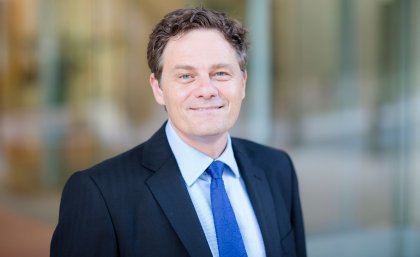
A University of Queensland researcher who invented the Nanopatch – a needle-free vaccine delivery device – has been awarded the 2016 CSL Young Florey Medal.
The award Professor Mark Kendall received this evening from the Australian Institute of Policy and Science (AIPS) is one of Australia’s highest science honours and recognises his achievements in a career that spans rocket technology and biomedical engineering.
The award is given in honour of penicillin co-inventor Sir Howard Florey, who in 1945 became Australia’s first Nobel Laureate in Medicine.
“It is very humbling and a great honour to receive this award,” Professor Kendall said.
“Sir Howard Florey was a hugely inspiring individual. What he accomplished is scientific folklore.”
Australian Institute for Bioengineering and Nanotechnology director Professor Alan Rowan congratulated Professor Kendall and said the Nanopatch was destined to improve the health of millions of people worldwide.
“UQ has a strong history of commercialising research findings into practical solutions,” Professor Rowan said.
“It’s this kind of research that is making UQ a rising star on various research-related international rankings tables, and Brisbane and Queensland a research leader nationally.”
Professor Rowan said that traditionally, the need to keep vaccines chilled had made vaccination schemes logistically challenging in remote and disadvantaged areas.
“Vaccines coated onto the Nanopatch do not need to be kept cold, and may require less vaccine for effective immunisation when compared to traditional needle and syringe methods,” he said.
Professor Kendall first completed a PhD in hypervelocity aerodynamics at UQ.
“It didn’t seem that I was destined for medicine at all,” he said.
“But Oxford University recruited me to work on using aerodynamic principles to fire vaccines into the skin.”
This work, with others, led to the development of a “gene gun”.
“It’s basically a hand-held rocket that uses hypervelocity aerodynamics for the ballistic delivery of vaccine-coated micro-particles into the skin, leading to an improved immunological effect,” Professor Kendall said.
He returned to UQ in 2006 and joined the Australian Institute for Bioengineering and Nanotechnology to work on a different concept, using the skin’s immune-rich cellular environment as a vaccine delivery target.
“I was eager to overcome one of the gene gun’s biggest challenges, which was making it practical for mass vaccination in developing areas of the world,” Professor Kendall said.
“It was too expensive and too complex for field use in low-resource regions.
“To resolve this, I mapped the skin’s immune system and designed a device from the ground-up that targets immune-rich cells in the skin using microscopic projections. This became the Nanopatch.”
Professor Kendall, with his team and collaborators, concurrently explored fundamental science at the interface of engineering, chemistry, biomaterials and immunology.
Along the way, they overcame practical hurdles including inventing ways to precisely coat vaccines on to projections so small that they cannot be seen by the human eye, and finding solutions for large-scale manufacture at low cost.
“Although I’m a trained engineer, my eye was constantly on the biological problem of proving the value of the Nanopatch – does it make vaccines work better than a needle and syringe?” Professor Kendall said.
Studies in animals proved the device was effective, achieving equivalent immune responses as the needle and syringe but using lower doses of vaccine.
The technology took a significant innovation step in 2011 with the formation of Vaxxas Pty Ltd, a start-up company established to commercialise the Nanopatch.
The Nanopatch is undergoing clinical trials, and is being tested in collaboration with the World Health Organisation for vaccination against poliovirus.
AIPS general manager Ms Camille Thomson congratulated Professor Kendall, and said his research had the potential to improve the health of millions of people worldwide.
“Mark Kendall could transform vaccination, just as Florey transformed the treatment of bacterial diseases,” Ms Thomson said.
Two UQ researchers have previously won the CSL Florey Medal, which recognises lifetime achievement in biomedical science: Professor Ian Frazer in 2006 for his work on the Gardasil cervical cancer vaccine, and Professor Perry Bartlett last year for his ground-breaking discoveries in neuroscience.
The CSL Young Florey Medal is awarded to outstanding scientists for significant early career achievements in biomedical science and/or human health advancement, and who have shown excellence and passion in promoting science.
Professor Kendall said the award had a particular resonance for him, because at Oxford he had worked in a building where Florey once worked.
Media: Darius Koreis, d.koreis@uq.edu.au, +61 7 3346 3962, +61 427 148 187.
.jpg)










